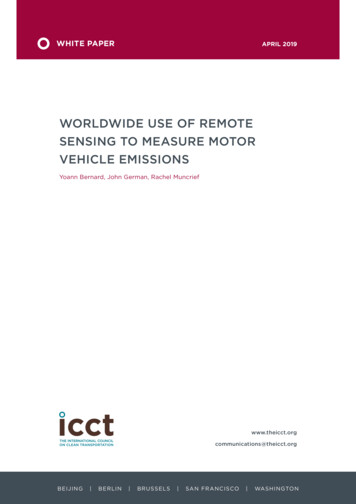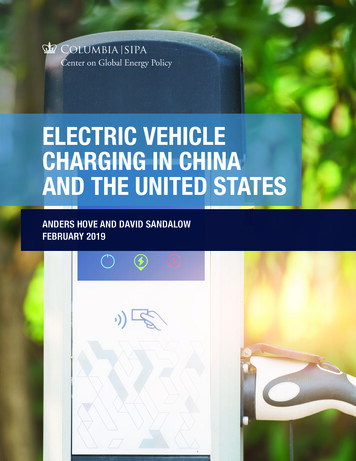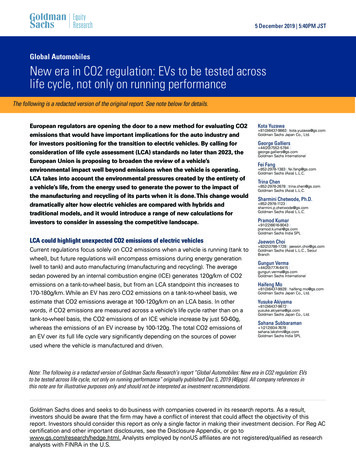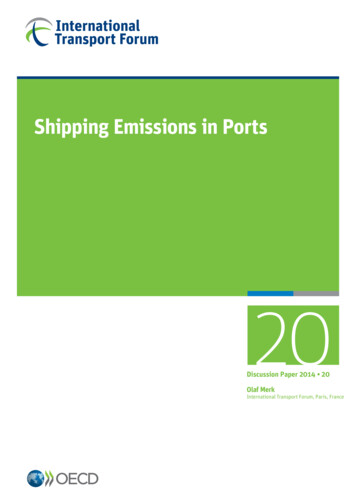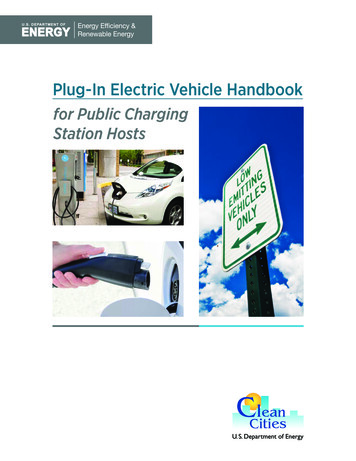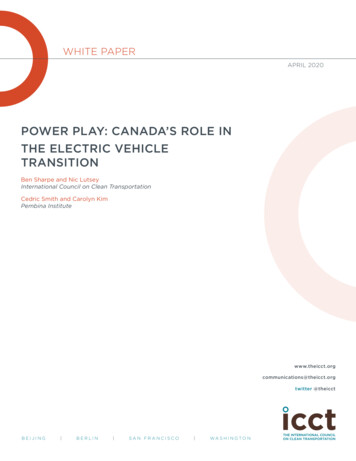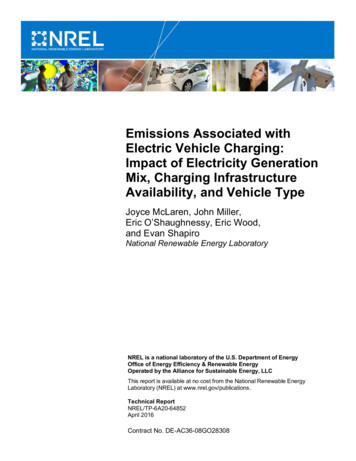
Transcription
Emissions Associated withElectric Vehicle Charging:Impact of Electricity GenerationMix, Charging InfrastructureAvailability, and Vehicle TypeJoyce McLaren, John Miller,Eric O’Shaughnessy, Eric Wood,and Evan ShapiroNational Renewable Energy LaboratoryNREL is a national laboratory of the U.S. Department of EnergyOffice of Energy Efficiency & Renewable EnergyOperated by the Alliance for Sustainable Energy, LLCThis report is available at no cost from the National Renewable EnergyLaboratory (NREL) at www.nrel.gov/publications.Technical ReportNREL/TP-6A20-64852April 2016Contract No. DE-AC36-08GO28308
Emissions Associated withElectric Vehicle Charging:Impact of Electricity GenerationMix, Charging InfrastructureAvailability, and Vehicle TypeJoyce McLaren, John Miller,Eric O’Shaughnessy, Eric Wood,and Evan ShapiroNational Renewable Energy LaboratoryPrepared under Task No. VTP2.0100NREL is a national laboratory of the U.S. Department of EnergyOffice of Energy Efficiency & Renewable EnergyOperated by the Alliance for Sustainable Energy, LLCThis report is available at no cost from the National Renewable EnergyLaboratory (NREL) at www.nrel.gov/publications.National Renewable Energy Laboratory15013 Denver West ParkwayGolden, CO 80401303-275-3000 www.nrel.govTechnical ReportNREL/TP-6A20-64852April 2016Contract No. DE-AC36-08GO28308
NOTICEThis report was prepared as an account of work sponsored by an agency of the United States government.Neither the United States government nor any agency thereof, nor any of their employees, makes any warranty,express or implied, or assumes any legal liability or responsibility for the accuracy, completeness, or usefulness ofany information, apparatus, product, or process disclosed, or represents that its use would not infringe privatelyowned rights. Reference herein to any specific commercial product, process, or service by trade name,trademark, manufacturer, or otherwise does not necessarily constitute or imply its endorsement, recommendation,or favoring by the United States government or any agency thereof. The views and opinions of authorsexpressed herein do not necessarily state or reflect those of the United States government or any agency thereof.This report is available at no cost from the National Renewable EnergyLaboratory (NREL) at www.nrel.gov/publications.Available electronically at SciTech Connect http:/www.osti.gov/scitechAvailable for a processing fee to U.S. Department of Energyand its contractors, in paper, from:U.S. Department of EnergyOffice of Scientific and Technical InformationP.O. Box 62Oak Ridge, TN 37831-0062OSTI http://www.osti.govPhone: 865.576.8401Fax: 865.576.5728Email: reports@osti.govAvailable for sale to the public, in paper, from:U.S. Department of CommerceNational Technical Information Service5301 Shawnee RoadAlexandria, VA 22312NTIS http://www.ntis.govPhone: 800.553.6847 or 703.605.6000Fax: 703.605.6900Email: orders@ntis.govCover Photos by Dennis Schroeder: (left to right) NREL 26173, NREL 18302, NREL 19758, NREL 29642, NREL 19795.NREL prints on paper that contains recycled content.
AcknowledgmentsThis work was funded by the Department of Energy’s Vehicle Technologies Program as part ofthe Workplace Charging Challenge initiative. The authors would like to thank the followingindividuals for their valuable contributions and reviews: Wendy Dafoe, David Hurlbut, CaleyJohnson, Venkat Krishnan, Trieu Mai, Marc Melaina, Margo Melendez, Chris Nelder, JeremeyNewbauer, Joshua Novacheck, Matthew O’Connell, Emerson Reiter, and Jake Ward. Theauthors are solely responsible for any omissions or errors contained herein.iiiThis report is available at no cost from the National Renewable Energy Laboratory (NREL) at www.nrel.gov/publications.
AbstractWith the aim of reducing greenhouse gas emissions associated with the transportation sector,policymakers are supporting a multitude of measures to increase electric vehicle adoption. Theactual amount of emissions reduction electric vehicles provide is dependent on when and wheredrivers charge the vehicles. This analysis contributes to our understanding of the degree to whicha particular electricity grid profile, the vehicle type, and charging patterns impact CO 2 emissionsfrom light-duty, plug-in electric vehicles. We present an analysis of anticipated emissionsresulting from both battery electric and plug-in hybrid electric vehicles for four chargingscenarios and five electricity grid profiles. A scenario that allows drivers to charge electricvehicles at the workplace yields the lowest level of emissions for the majority of electricity gridprofiles. However, vehicle emissions are shown to be highly dependent on the percentage offossil fuels in the grid mix, with different vehicle types and charging scenarios resulting in feweremissions when the carbon intensity of the grid is above a defined level. Restricting charging tooff-peak hours results in higher total emissions for all vehicle types, as compared to othercharging scenarios.ivThis report is available at no cost from the National Renewable Energy Laboratory (NREL) at www.nrel.gov/publications.
Table of ContentsIntroduction and Background . 1Methodology . 3Electricity Grid Profiles. 3Calculating Electrical Load from EV Charging . 4Calculating Emissions Associated with the Scenarios . 6Electricity Load Profiles Associated with EV Charging . 8Analysis of Emissions Associated with Miles Driven on Electricity . 10Emissions Associated with Non-Electricity Miles . 16Total Emissions Results: Emissions from Electric Non-Electric Miles . 16Sensitivity Analysis . 20Conclusions . 24References . 26vThis report is available at no cost from the National Renewable Energy Laboratory (NREL) at www.nrel.gov/publications.
Introduction and BackgroundWith the aim of reducing greenhouse gas emissions associated with the transportation sector,decision makers at the national, state, and local levels are supporting a multitude of policymeasures to increase adoption of light-duty electric vehicles (DOE 2015; DeShazo 2015; ICCT2015; Zhou 2015). The actual emission-reduction benefits associated with plug-in electricvehicles (PEVs) in a specific location are dependent on multiple factors, such as the electricitygeneration fuel mix, the time of day charging, and the vehicle type. Using a wide variety ofmethodologies and assumptions, numerous studies have investigated the impact of these differentfactors on emissions (Hacker 2007; Parks 2007; Anaire 2012; Kelly 2012; RAP/ICCT 2013;Nunes 2014; Tulpule 2014; Nealer 2015; Wood 2015; Jochem 2016).A 2012 Union of Concerned Scientists (UCS) study concludes that emissions from electricvehicles are less than those of an average conventional vehicle, regardless of mix of fuels used togenerate the electricity on which they are charged (Anair 2012). While the authors of the studyacknowledge the impact of location and time of day that charging occurs, they do not specificallycalculate PEV emissions for different grid mixes, stating:Because the hourly variations in emissions intensity are not consistent acrossregions, times of day, or seasons, it is not practical to develop general consumerguidelines on when the lowest emissions intensity will occur throughout the day.For now, we recommend that EV consumers use their regional grid emissions,averaged over the course of the year, as a guide to estimating their personal EVglobal warming emissions.Several studies have quantified the importance of location and time of day when estimating PEVemissions. Tulpule (2013) concludes that day charging with solar-powered charging stations inOhio could realize CO 2 emissions reductions of up to 90% versus home charging during eveninghours. Jochem et al. (2015) finds that total life-cycle external costs of PEVs are highly dependenton the electricity mix and the charging strategy employed.While a commonly used methodology bases emissions estimates on the annual averageelectricity generation mix (Hacker 2007), an alternative approach bases calculations on theelectricity fuel source that is on the margin (meaning the electricity load that PEVs add to theexisting load). 1 Holland et al. (2015) take this approach, finding significant variation in themarginal emissions associated with PEVs in different locations, thus reinforcing the notion thatelectricity grid mix has a notable impact on emissions. The authors also point out the potentialfor the transfer of the emissions benefits of EVs from one location to another, as a result ofregional electricity imports and exports. Parks et al. (2007) and Denholm et al. (2013) also usethe marginal emission methodology. Both studies conclude that the availability of daytimecharging increases the percentage of miles that plug-in hybrid electric vehicles (PHEVs) drive onelectricity and results in greater petroleum displacement.1As pointed out in the Union of Concerned Scientists study, these calculations based on the marginal fuel sourceprovide insight into the impact of large-scale PEV deployment on electricity grids, but basing calculations on theaverage electricity generation mix may be more suitable to inform policy and consumer decision-making.1This report is available at no cost from the National Renewable Energy Laboratory (NREL) at www.nrel.gov/publications.
The analysis described in this paper investigates the emissions impacts by time of day andcharging scenario for five different electricity grid mixes and multiple vehicle types. Weinvestigate both PHEVs and BEVs that are charged using either slow (level 1) or fast (level 2)charging equipment at varying times of day. The electricity grids on which the vehicles arecharged differ in their carbon intensities. Each grid is characterized by an hourly generationprofile for an entire week. Seasonal variations are not captured because the profiles represent theaverage fuel mix over the course of a year. 2A strength of our methodological approach is the consideration of not only the emissionsassociated with charging electric vehicles on a particular electricity grid, but also the emissionsassociated with the non-electric miles driven. This includes the miles that PHEVs drive ingasoline mode, and those trips that battery electric vehicle (BEV) drivers are required to make ina conventional vehicle (CV). As such, we are able to provide a more complete representation oftotal emissions associated with PEV-owner travel. Including CV emissions enables this analysisto capture the more nuanced story of PEV use.Battery electric vehicle (BEV)100% electricity-operatedPlug-in hybrid electric vehicle(PHEV)Can operate on both electricity andinternal combustionConventional vehicle (CV)100% internal combustionFigure 1. Descriptions and symbols for vehicles studied2The vehicles modeled represent efficiencies anticipated for 2025.2This report is available at no cost from the National Renewable Energy Laboratory (NREL) at www.nrel.gov/publications.
MethodologyElectricity Grid ProfilesFor this study, we modeled five different electricity grids with a variety of fuel mixes. The gridsbroadly represent regions across the United States and their different levels of carbon intensity.The profiles were generated using the production cost model PLEXOS (Energy Exemplar 2015),which simulates the least-cost dispatch of the electric power system, taking into account hourlyvariations in demand and numerous operational constraints. PLEXOS models electricity dispatchfrom generating units at intervals as short as five minutes. This analysis simulated hourlydispatch intervals for an entire year, for each of five grids. These results were aggregated toproduce annual average hourly profiles (shown in Figure 1). The main analysis is based on a‘standard scenario,’ which assumes moderate renewable energy build-out and accounts forcurrently planned closures of coal facilities and anticipated growth in natural gas generation(Brinkman 2015; Bloom et al. 2016). In addition, a sensitivity analysis (presented in a latersection) was conducted for cases with high and low percentages of renewable energy.Figure 2 shows the five grid profiles used in the main analysis, which represent a broad spectrumof low to high carbon intense grids. Although the example of the low carbon grid is composedlargely of renewable energy, a grid with nuclear, hydropower, or other emissions-free generationsources would yield similar results.Figure 2. Modeled grid profiles representing varying levels of carbon intensitySource: Brinkman (2015)3This report is available at no cost from the National Renewable Energy Laboratory (NREL) at www.nrel.gov/publications.
Calculating Electrical Load from EV ChargingWe calculated the hourly electrical load profiles associated with EV charging for 28 differentscenarios (7 vehicle types and 4 charging scenarios). NREL’s Battery Lifetime Analysis andSimulation Tool for Vehicles (BLAST-V) model was used to generate the hourly electrical loadsover an entire week for each scenario (NREL 2015a). BLAST-V incorporates data on behavioraldriving tendencies of EV drivers based on actual observations into its simulations to determinescenario-specific hourly vehicle load demand ( NREL 2015b). Publicly available data from theCalifornia Department of Transportation 2010-2012 Household Travel Study was used tocharacterize travel (NREL 2015b; Nutstats Research Solutions 2013). Inputs to the BLAST-Vmodel included the vehicle type, the types and locations of charging infrastructure available todrivers, and the set of trips requested by the drivers. The vehicle type and charging infrastructureavailable to the driver was varied in each BLAST-V run, while the set of trips requested bydrivers remained constant. Outputs of each BLAST-V run included the number of electric miles,the number of non-electric miles, and the kilowatt-hours needed for charging for each hour of theweek. Non-electric miles are those that PHEVs drive in gasoline mode, and those trips that BEVdrivers are required to make in a conventional vehicle.Figure 3 depicts the seven vehicle types modeled, which include both PHEVs and BEVs. Thefigure also indicates the range the vehicles are assumed to be capable of traveling on a fullcharge under the standard U.S. Environmental Protection Agency’s urban dynamometer drivingschedule (unadjusted estimates). The vehicle range was adjusted in BLAST-V by approximately30% to account for real-world effects including speed, acceleration rate, ambient temperature,and cabin heating and cooling (EPA 2006). Given the amount of data gathered from the multipleruns and the similarity of many of the conclusions across vehicle ranges, we present the detailedresults for only the BEV200 and the PHEV30 in some cases.Figure 3. Vehicle types and ranges modeledThe four charging scenarios simulated represent a variety of situations, with three home-onlycharging scenarios and one home-plus-workplace charging scenario. 3 In the home charging3Public charging stations were not made available to the vehicles during BLAST-V simulation.4This report is available at no cost from the National Renewable Energy Laboratory (NREL) at www.nrel.gov/publications.
scenarios, drivers were either allowed charge their vehicle whenever they were home (alsoknown as opportunity charging) with a Level 1 or Level 2 charger, 4 or were restricted tocharging between midnight and 1 p.m. with a Level 2 charger. This ‘time-restricted’ chargingscenario represents the incentives that utilities are increasingly offering EV owners to chargeduring off-peak hours. 5 Table 1 summarizes the five different charging scenarios modeled foreach vehicle type in this study.Note that smart charging is not included in any of the charging scenarios. While research hasshown that charging infrastructure that incorporates advanced controls can be a potentiallyimportant mechanism to manage load from PEV charging to reduce system impacts andemissions (Garcia-Villalobos 2014), uncontrolled charging is likely to remain the standard forsome time.Table 1. Charging Scenarios ModeledScenarioNameWhere can youcharge?When can youcharge?ChargingTechnology/SpeedHome L1Only at homeAnytimeLevel 1Home L2Only at homeAnytimeLevel 2TimeRestrictedOnly at homeMidnight-1 p.m.onlyLevel 2WorkplaceAt Home & workAnytimeLevel 2As mentioned above, the BLAST-V model calculates the number of electric miles and nonelectric miles driven for each scenario. The same trips are taken in every scenario, and thus thesame numbers of miles are driven. However, because of the technical differences in the vehicles,the method BLAST-V uses to determine the ratio of electric to non-electric miles differs for theBEV and PHEVs.For the BEV scenarios, when a journey is requested, a BEV owner must choose whether to drivetheir BEV or a CV. The BLAST-V model assumes that owners choose to drive their BEV if thetrip is comfortably within the vehicle’s range at its current state of charge. If the current state ofcharge is insufficient to make the trip, the owner drives a CV. The same number and length oftrips are taken for every scenario; it is assumed that drivers do not forego a trip simply becausethey cannot make it using their BEV.4Level 1 chargers are standard for all vehicles and do not require any specialized equipment. They use 120 volt,alternating current and a standard household plug, however a dedicated circuit is necessary. Level 2 chargers supply240 volt, alternating current. They require the installation of specialized charging equipment and a dedicated 40 ampcircuit. Level 2 chargers typically take about half of the time of a Level 1 charger to fully charge a depleted battery.5The Alternative Fuels Data Center database lists at least 18 utilities that have special time-of-use rates for ownersof electric vehicles (http://www.afdc.energy.gov/fuels/laws/ELEC). One study found that EV owners with time-ofuse pricing generally began charging their vehicles around midnight, when lower rates are available (Ecotality andIdaho National Laboratory 2013).5This report is available at no cost from the National Renewable Energy Laboratory (NREL) at www.nrel.gov/publications.
For the PHEV scenarios, the PHEV operates in electric mode until the vehicle exceeds thebattery’s range at its current state of charge, at which time it switches to gasoline mode, whichresults in non-electric miles.Calculating Emissions Associated with the ScenariosThe level of emissions associated with each charging scenario is based on the carbon intensity ofthe electricity grid at the specific time of day the vehicles are charged, the emissions associatedwith burning gasoline, the ratio of electric-to-gasoline miles driven, and the efficiencies of thevehicles.To calculate emissions for electric miles driven, each electricity generation fuel source wasassigned an emission factor (lbs CO 2 /kWh) (see Figure 4) and the methodology employed byBrinkman (2015). There are two emissions factors for natural gas; one represents the moreefficient heat rate of combined cycle plants. These emissions factors were applied to theelectricity mixes for each of the five grid profiles studied to arrive at the hourly carbon intensityfor each profile.Figure 4. Emissions factors of fuel sourcesSource: Brinkman (2015)*Natural gas emission factor is the average of combustion turbine and combined cycle emission factors.The emissions associated with the non-electric miles are a function of the vehicle efficiency,which differs between BEVs and PHEVs. For the PHEV scenarios, the emissions associated withthe non-electric miles are assumed to be 0.29 lb CO 2 /mile (based on the 66.8 mpg efficiencyanticipated for 2025). 6 The emissions associated with the miles driven in the conventionalvehicle are assumed to be 0.48 lb CO 2 /mile (based on a 40.8 mpg efficiency anticipated for2025). 7 Figure 5 illustrates the methodologies used to calculate emissions from both the BEVand PHEV scenarios.6Modeling is based on a 2025 vehicle efficiency rating of 66.8 mpg (the anticipated PHEV vehicle fuel economyaccording to the U.S. Department of Energy [DOE] and the Government Performance and Results Act [GPRA]) andan emissions factor of 8.91 kg (19.64 lb) CO2/gallon gasoline (EIA 2013).7Modeling is based on a 2025 vehicle efficiency of 40.8 mpg (the anticipated conventional vehicle fuel economyaccording to DOE/GPRA) and an emissions factor of 8.91 kg (19.64 lb) CO2/gallon gasoline (EIA 2013). Currentyear vehicles that are still on the road in 2025 were not modeled.6This report is available at no cost from the National Renewable Energy Laboratory (NREL) at www.nrel.gov/publications.
Figure 5. Methodologies used to calculate emissions from BEVs and PHEVsFigure 6 shows the distribution of electric miles and non-electric miles, by vehicle type andcharging scenario, as calculated by the BLAST-V model. It indicates that BEV scenariosgenerally result in more miles driven on electricity than the PHEV scenarios. We also see thatthe Home L2 and Workplace scenarios result in the greatest number of miles driven onelectricity, and the lowest mileage driven on gasoline. This is true for every vehicle model. Thefaster charging afforded by the Level 2 chargers and the greater frequency of charging affordedby the availability of workplace charging allow BEV owners to charge more over the course of atypical day and drive their BEV for more electric miles. Likewise, more charging afforded byfast home charging and workplace charging allows PHEV drivers to operate their vehicle inelectric mode for a higher proportion of their total mileage.7This report is available at no cost from the National Renewable Energy Laboratory (NREL) at www.nrel.gov/publications.
Figure 6. Distribution of electric versus non-electric miles traveled,by vehicle type and charging scenarioNote: Non-electric miles for BEVs result from the use of a conventional vehicle to make trips that wouldnot be possible in the BEV due to the state-of-charge at the time the trip was requested. The non-electricmiles for the PHEVs result from the use of the PHEV in gasoline mode (also known as charge-sustainingmode). Because of the difference in efficiency of the CV and the PHEV, the emissions associated with aBEV non-electric mile are higher than the emissions of the PHEV non-electric mile.Electricity Load Profiles Associated with EV ChargingFigures 7 and 8 show the annual average load profiles for the four charging scenarios modeled,for the BEV200 and the PHEV30. The load shapes were not significantly different for the othervehicle ranges. In addition, there is little difference between the load shapes of the BEVs ascompared to PHEVs. The main difference is the higher overall load of the BEV.Three of the charging scenarios show a clear peak during the evening hours. However, note thatthe load shape for the time-restricted scenario clearly indicates the lack of charging between 1pmand midnight. Load is very high (6,200 kilowatts) at midnight (when charging is initiallyallowed) and drops sharply as vehicles become fully charged. The load ramps up again in themorning before dropping to zero at 1 p.m. (when charging restrictions begin).8This report is available at no cost from the National Renewable Energy Laboratory (NREL) at www.nrel.gov/publications.
Figure 7. BEV load profile by scenarioNote: The scale in the figure is capped at 1,500 kW for presentation purposes (the time restrictedscenario peaks at 6,200 kW at 12 a.m.).Figure 8. PHEV load profile by scenarioNote: The scale is capped at 1,500 kW for presentation purposes (the time restricted scenario peaks at5,700 kW at 12 a.m.).9This report is available at no cost from the National Renewable Energy Laboratory (NREL) at www.nrel.gov/publications.
Analysis of Emissions Associated with Miles Drivenon ElectricityThe following analysis figures (Figures 9–13) provide detailed results for the five generationprofiles and four charging scenarios studied. The layout of the figures elucidates the relationshipsbetween the multiple variables of interest and allows us to compare of the hourly generationprofile and CO 2 intensity of the grid with the hourly load and cumulative grid-based CO 2emissions for each charging scenario. Note that Figures 9–13 only include the emissionsresulting from the miles driven on electricity. They do not include emissions resulting from nonelectric miles; these are presented separately in subsequent sections.On a low-carbon grid (Figure 9), CO 2 intensity spikes during the evening ‘peak hours’ between 6p.m. and midnight. This spike results in higher grid-based emissions for charging scenarios thathave high loads in the evening hours (e.g., Home L2 and Workplace charging). However, theemissions from electricity miles are low in all charging scenarios, because of the minimal use ofcarbon-based fuels. On low-carbon grids, conventional vehicle miles have a significantly highercarbon intensity than electric miles, favoring the charging scenarios that allow for more milesdriven on electricity (i.e., Workplace charging).10This report is available at no cost from the National Renewable Energy Laboratory (NREL) at www.nrel.gov/publications.
Figure 9. Analysis figure for low carbon gridNote: Figure based on BEV emissions.11This report is available at no cost from the National Renewable Energy Laboratory (NREL) at www.nrel.gov/publications.
The medium-low carbon grid (Figure 10) has a relatively steady CO 2 intensity throughout the24-hour period. Because of this, the load shapes for the different charging scenarios have littleimpact on total emissions. The difference in total emissions between the scenarios in this case, isdependent more on the ratio between electric and non-electric miles. Workplace charging resultsin higher grid emissions because it allows for more miles driven on electricity, but whenemissions from non-electric miles are considered, the scenario results in fewer total emissionsthan the others (see Figure 15).Figure 10. Analysis figure for med-low carbon gridNote: Figure based on BEV emissions.12This report is available at no cost from the National Renewable Energy Laboratory (NREL) at www.nrel.gov/publications.
The medium carbon grid (Figure 11) has an obvious dip in carbon intensity during the mid-dayhours, favoring charging scenarios that have a higher percentage of load between mid-morningand mid-afternoon. Home L1 and Workplace charging scenarios result in the lowest gridemissions in this scenario, followed closely by Home L2. Time restricted charging results in thehighest grid emissions, since the majority of the load occurs between midnight and 6 a.m., whencarbon intensity is high.Figure 11. Analysis figure for medium carbon gridNote: Figure based on BEV emissions.13This report is available at no cost from the National Renewable Energy Laboratory (NREL) at www.nrel.gov/publications.
The medium-high carbon grid (Figure 12), like the medium-low, has a fairly uniform carbonintensity throughout the day, making the load profile less significant in distinguishing betweencharging scenarios. Therefore, the total load, based on the total miles driven on electricity foreach scenario, is responsible for the differences between emissions for the scenarios. Workplacecharging has the highest grid emissions because of the higher number of miles that are driven onelectricity.Figure 12. Analysis figure for medium-high carbon gridNote: Figure based on BEV emissions.14This report is available at no cost from the National Renewable Energy Laboratory (NREL) at www.nrel.gov/publications.
On the high carbon grid (Figure 13), the Home L1 and L2 charging scenarios result in the lowestgrid emissions. Workplace charging results in the most grid emissions, with the higherproportion of electric miles afforded by workplace charging not acting as an advantage, in thiscase.Figure 13. Analysis figure for high carbon grid regionNote: Figure based on BEV emissions.15This report is available at no cost from the National Renewable Energy Laboratory (NREL) at www.nrel.gov/publications.
Emissions Associated with Non-Electricity MilesFigure 14 shows the emissions associated only with non-electric miles for the different chargingscenarios. These are the emissions from driving the PHEV in gasoline mode and driving aconventional vehicle for trips unable to be made in a BEV. The results are similar for vehicleswith different ranges, so we present only one set here.Not surprisingly, the PHEV has more emissions from miles driven on gasoline because thePHEV drives more non-electric miles. For all scenarios, these emissions must be added to thoseassociated with vehicle charging in order to gain a complete unde
generation fuel mix, the time of day charging, and the vehicle type. Using a wide variety of methodologies and assumptions, numerous studies have investigated the impact of these different factors on emissions (Hacker 2007; Parks 2007; Anaire 2012; Kelly 2012; RAP/ICCT 2013; Nunes 2014; Tulpule 2014; Nealer 2015; Wood 2015; Jochem 2016).
